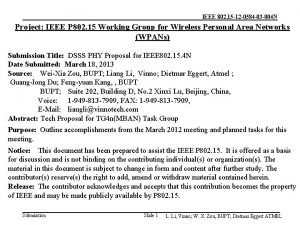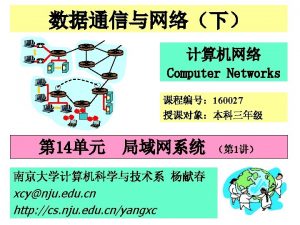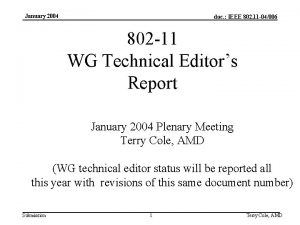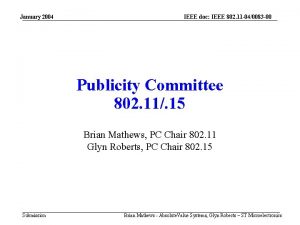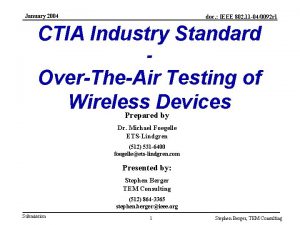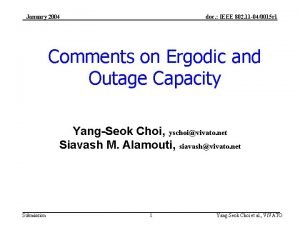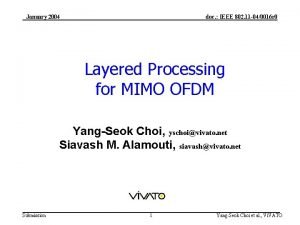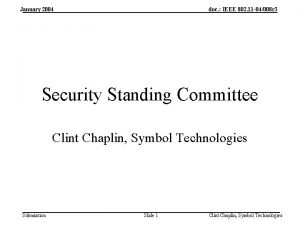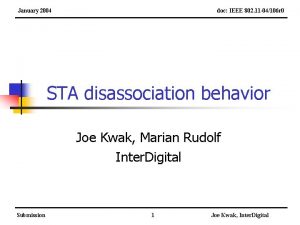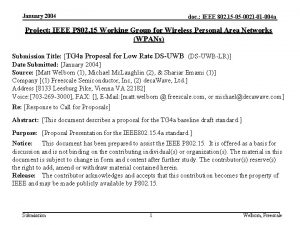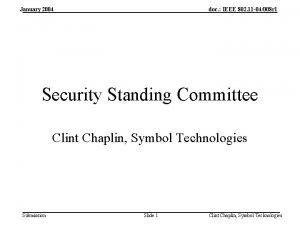January 2004 doc IEEE 802 11 040071 r











![January 2004 doc. : IEEE 802. 11 -04/0071 r 1 References [1] IEEE 802. January 2004 doc. : IEEE 802. 11 -04/0071 r 1 References [1] IEEE 802.](https://slidetodoc.com/presentation_image_h2/1ae1cd14f385f9ee7a7d21d7be3de150/image-12.jpg)
- Slides: 12

January 2004 doc. : IEEE 802. 11 -04/0071 r 1 LDPC vs. Convolutional Codes for 802. 11 n Applications: Performance Comparison January 2004 Aleksandar Purkovic, Nina Burns, Sergey Sukobok, Levent Demirekler Nortel Networks (contact: apurkovi@nortelnetworks. com) Submission 1 Aleksandar Purkovic, Nortel Networks

January 2004 doc. : IEEE 802. 11 -04/0071 r 1 Outline • Background • Simulation Methodology • Simulation Results – – – Packet Error Rate (PER) vs. SNR Throughput vs. SNR PHY data rate vs. distance LDPC – Convolutional coding gain difference vs. Block size Demonstration of embedded interleaving capability of LDPC codes • Summary and Conclusions • References Submission 2 Aleksandar Purkovic, Nortel Networks

January 2004 doc. : IEEE 802. 11 -04/0071 r 1 Background • Advanced coding has been identified as one of techniques to be considered in the process of 802. 11 n standard development (among other considerations, such as MIMO, higher order modulations, MAC efficiency improvement, etc. ) • Advanced coding candidates: Turbo coding, LDPC, Trellis Coded Modulation, more powerful convolutional codes, etc. • Contribution IEEE 802. 11 -03/865 (Intel, Albuquerque meeting), [1] introduced Low-Density Parity-Check (LDPC) codes as candidate codes for 802. 11 n applications. It showed potential advantages of those codes over existing convolutional codes used currently (802. 11 a/g). • This submission compares performance of example LDPC codes and existing (802. 11 a/g) convolutional codes in a systematic fashion, with: – Various frame lengths – Various code rates – Various line conditions (channel models) • At this time performance comparison is addressed only, in order to justify further consideration of LDPC codes. In the next related submission (planned for March 2004 meeting) emphasis will be on performance/complexity tradeoffs for both: existing convolutional codes and candidate LDPC codes. Submission 3 Aleksandar Purkovic, Nortel Networks

January 2004 doc. : IEEE 802. 11 -04/0071 r 1 Simulation Methodology - General • PHY model based on the 802. 11 a spec [2] expanded with 256 -QAM constellation. Simulation included: Data Rate (Mbits/s) Modulation Coding Rate (R) 6 9 12 18 24 36 48 54 64 72 BPSK QPSK 16 QAM 64 QAM 256 QAM 1/2 3/4 2/3 3/4 • Channels simulated: – AWGN channel – Fading Channel Model D with power delay profile as defined in [3], NLOS, without simulation of Doppler spectrum. This implementation utilized the reference MATLAB code [4]. • Simulation scenario assumed: – Ideal channel estimation – All packets detected, ideal synchronization, no frequency offset – Ideal front end, Nyquist sampling frequency Submission 4 Aleksandar Purkovic, Nortel Networks

January 2004 doc. : IEEE 802. 11 -04/0071 r 1 Simulation Methodology - FEC • General FEC: – Packet lengths: 40, 200, 600, 1500 bytes, chosen based on distributions in [1] and [5] – Code rates: 1/2, 2/3, 3/4 (as in 802. 11 a) – Uniform bit loading • Convolutional codes: – Viterbi decoding algorithm • LDPC codes: – Iterative Sum-Product decoding algorithm with 50 iterations – Concatenated codewords for longer packets Submission 5 Aleksandar Purkovic, Nortel Networks

January 2004 doc. : IEEE 802. 11 -04/0071 r 1 Simulation Results: PER vs. SNR AWGN Channel Model D Submission 6 Aleksandar Purkovic, Nortel Networks

January 2004 doc. : IEEE 802. 11 -04/0071 r 1 Simulation Results: Throughput vs. SNR Throughput = PHY_data_rate (1 - PER) AWGN Channel Model D Submission 7 Aleksandar Purkovic, Nortel Networks

January 2004 doc. : IEEE 802. 11 -04/0071 r 1 Simulation Results: PHY Data Rate vs. Distance Channel Model D path loss Tx power: 23 d. Bm Noise figure: 10 d. B Implementation margin: 5 d. B PER: 10 -1 Submission 8 Aleksandar Purkovic, Nortel Networks

January 2004 doc. : IEEE 802. 11 -04/0071 r 1 Simulation Results: LDPC – Convolutional Coding Gain Difference vs. Block Size Modulation: BPSK Code rate: 1/2 Coding gain difference measured at PER of 10 -2 Submission 9 Aleksandar Purkovic, Nortel Networks

January 2004 doc. : IEEE 802. 11 -04/0071 r 1 Simulation Results: Embedded Interleaving Capability Demonstration Channel Model D Code rate: 1/2 Block size: 40 bytes Block size: 200 bytes Submission 10 Aleksandar Purkovic, Nortel Networks

January 2004 doc. : IEEE 802. 11 -04/0071 r 1 Summary and Conclusions • LDPC codes offer considerable performance advantages over the existing convolutional codes. • With the proper design LDPC codes can be made flexible enough to satisfy demands of 802. 11 n applications. • LDPC codes have an inherent feature which eliminates need for the channel interleaver (this was already pointed out in [1]). • Preliminary complexity analysis showed that reasonable solution is feasible. A submission on the performance/complexity analysis and potential real system design tradeoffs is planned for the March meeting. Submission 11 Aleksandar Purkovic, Nortel Networks
![January 2004 doc IEEE 802 11 040071 r 1 References 1 IEEE 802 January 2004 doc. : IEEE 802. 11 -04/0071 r 1 References [1] IEEE 802.](https://slidetodoc.com/presentation_image_h2/1ae1cd14f385f9ee7a7d21d7be3de150/image-12.jpg)
January 2004 doc. : IEEE 802. 11 -04/0071 r 1 References [1] IEEE 802. 11 -03/865 r 1, “LDPC FEC for IEEE 802. 11 n Applications”, Eric Jacobson, Intel, November 2003. [2] IEEE Std 802. 11 a-1999, Part 11: Wireless LAN Medium Access Control (MAC) and Physical Layer (PHY) Specifications, High-speed Physical Layer in the 5 GHz Band [3] IEEE 802. 11 -03/940 r 1, “TGn Channel Models”, TGn Channel Models Special Committee, November 2003. [4] Laurent Schumacher, “WLAN MIMO Channel Matlab program, ” October 2003, version 2. 1. [5] Packet length distribution at NASA Ames Internet Exchange (AIX), http: //www. caida. org/analysis/AIX/plen_hist/. Submission 12 Aleksandar Purkovic, Nortel Networks











